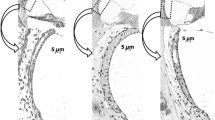Summary
Here we report of the ultrahistochemical representation of the cell coat at the supporting and the neurosensory cells of the guinea-pigs cochlea by means of the Rutheniumred-contrastation. This Rutheniumred-contrastation was performed as well by the original method, found out by Luft (1964) as by the modification of it, described 1968 by Monis and Zambrano. Partly the in vivo perfusion of the cochlea's perilymph spaces with the incubation medium was accomplished by the round window, partly there were brought into the Rutheniumred medium before fabricated preparations of pellicles. In the in vivo perfusion of the perilymph spaces a fine granular of fine lamellar precipitation of the Rutheniumred was to be seen at the apical plasmalemm of these room's epithel lining, at the tympanal lining-cell's surface, at the extracellular ground substance of the basilar membran and at the cell surfaces of the Reissner membran, turned to the scala vestibuli. At pellicle preparations, in addition, the apical plasmalemm of the supporting and neurosensory cells of the Corti organ, inclusive of the sterocilien and the microvilli als also the tectoria membran were surrounded by a Rutheniumred seam. In the interepithelial spaces of the Corti organ there could no Rutheniumred binding be proved. The zonulae occludentes formed permeability-barriers and were not contrasted. A second substrate-bound barrier probably builds up the Rutheniumred of itself. Between the two tryed methods for Rutheniumred-contrasting, in our examinations the Luft-method proved to be more favourable with respect to the penetration's degree and the intensity of the precipitate.
Zusammenfassung
Es wird über die ultrahistochemische Darstellung der Glykocalyx (Cell coat) an den Stütz- und Sinneszellen der Meerschweinchen-Cochlea mittels Rutheniumrot-Kontrastierung berichtet. Die Rutheniumrot-Kontrastierung erfolgte nach der von Luft (1964) erarbeiteten Originalmethode sowie nach der von Monis u. Zambrano (1968) beschriebenen Modifikation. Mit dem Inkubationsmedium wurde z. T. die in vivo-Perfusion der Perilymphräume der Cochlea über das runde Fenster durchgeführt, z. T. wurden zuvor angefertigte Häutchenpräparate in das rutheniumrothaltige Medium gebracht. Bei der in vivo-Perfusion der Perilymphräume wurde eine feingranuläre oder feinlamellöse Rutheniumrot-Präcipitaion am apikalen Plasmalemm der Epithelauskleidung dieser Räume, an der Oberfläche der tympanalen Belegzellen, an der extracellulären Grundsubstanz der Basilarmembran sowie an den der Scala vestibuli zugewandten Zelloberflächen der Reissnerschen Membran beobachtet. An Häutchenpräparaten wurden zusätzlich das apikale Plasmalemm der Stütz- und Sinneszellen des Corti-Organs einschließlich der Stereocilien und der Mikrovilli sowie die Membrana tectoria von einem rutheniumrotpositiven Saum umgeben. In den interepithelialen Räumen des Corti-Organs konnte keine Rutheniumrot-Bindung nachgewiesen werden. Die Zonulae occludentes bildeten Permeabilitätsbarrieren und wurden nicht kontrastiert. Eine zweite, substratgebundene Barriere baut das Rutheniumrot wahrscheinlich selbst auf. Von den beiden erprobten Methoden zur Rutheniumrot-Kontrastierung erwies sich bei unseren Untersuchungen die Luftsche Methode bezüglich des Penetrationsgrades und der Intensität des Präcipitates als günstiger.
Similar content being viewed by others
Literatur
Arnold, M., Hager, G.: Versuche zur elektronenmikroskopischen Darstellbarkeit saurer Mukopolysaccharide mit kolloidalen Eisenlösungen. Histochemie 17, 312–318 (1968)
Beck, Chl., Holz, E.: Die Mikropräparation der Cochlea. Acta oto-laryng. (Stockh.) 65, 327–336 (1968)
Bondareff, W.: An intercellulärer substance in rat cerebral cortex: submicroscopic distribution of ruthenium red. Anat. Rec. 157, 527–536 (1967)
Engström, H., Ades, H. W., Andersson, A.: Structurae pattern of the organ of Corti. Baltimore: The Williams u. Wilkins Co. 1966
Fasske, E., Steins, J.: Über die Anfärbbarkeit saurer Mucopolysaccharide mit Rutheniumrot. Z. wiss. Mikr. 67, 47–50 (1965)
Geyer, G., Schaaf, P., Möller, J., Müller, A., Linss, W., Feuerstein, H.: Ultrahistochemische Untersuchungen über das Ionenbindungsvermögen von Basalmembran und Glykokalyx. Acta histochem. (Jena) 36, 54 (1970)
Geyer, G., Küttner, K., Linss, W.: Ultrahistochemische Darstellung von Proteoglycanen in der Grundsubstanz der Basilarmembran am Ductus cochlearis des Meerschweinchens. Acta histochem. (Jena) 44, 171–175 (1972)
Geyer, G.: Ultrahistochemie. Histochemische Arbeitsvorschriften für die Elektronenmikroskopie. Jena: VEB G. Fischer 1973
v. Ilberg, Ch.: Elektronenmikroskopische Untersuchung über Diffusion und Resorption von Thoriumdioxyd an der Meerschweinchenschnecke. Arch. klin. exp. Ohr.-, Nas.- u. Kehlk.-Heilk. 190, 415–425 (1968a)
v. Ilberg, Ch.: Elektronenmikroskopische Untersuchung über Diffusion und Resorption von Thoriumdioxyd an der Meerschweinchenschnecke. Arch. klin. exp. Ohr.-, Nas.- u. Kehlk.-Heilk. 190, 426–436 (1968b)
v. Ilberg, Ch.: Elektronenmikroskopische Untersuchungen über Diffusion und Resorption von Thoriumdioxyd an der Meerschweinchenschnecke. Arch. klin. exp. Ohr.-, Nas.- u. Kehlk.-Heilk. 192, 384–400 (1968c)
Jahnke, K.: Elektronenmikroskopische Untersuchungen über die Permeabilitätsbarrieren des Innenohres. Arch. klin. exp. Ohr.-, Nas.- u. Kehlk.-Heilk. 204, 199–216 (1973)
Küttner, K., Geyer, G.: Elektronen- und lichtmikroskopische Untersuchungen zur Darstellung der Glykokalyx im Bereich des Ductus cochlearis des Meerschweinchens. Acta oto-laryng. (Stockh.) 74, 183–190 (1972)
Luft, J. H.: Electron microscopy of cell extraneous coats as revealed by ruthenium red staining. J. Cell Biol. 23, 54A-55A (1964)
Luft, J. H.: Ruthenium red and violet. I. Chemistry, purification, methods of use, and mechanisms of action. Private publication. J. H. Luft, Department of Biological Structure University of Washington Seattle
Merker, H. J., Günther, Th.: Die elektronenmikroskopische Darstellung von Glykosaminoglykanen in Geweben mit Rutheniumrot. Histochemie 34, 293–303 (1973)
Monis, B., Zambrano, D.: Ultrastructure of transitional epithelium of man. Z. Zellforsch. 87, 101–117 (1968)
Reimann, B.: Zur Verwendbarkeit von Rutheniumrot als elektronenmikroskopisches Kontrastierungsmittel. Mikroskopie 16, 224–226 (1961)
Tachibana, M., Saito, H., Machino, M.: Sulfated acid mukopolysaccharides in the tectorial membrane. Acta oto-laryng. (Stockh.) 76, 37–46 (1973)
Author information
Authors and Affiliations
Rights and permissions
About this article
Cite this article
Küttner, K. Ultrahistochemische Darstellung der Glykokalyx an Zellen der Meerschweinchen-Cochlea durch Rutheniumrot-Kontrastierung. Arch Otorhinolaryngol 208, 175–184 (1974). https://doi.org/10.1007/BF00456290
Received:
Issue Date:
DOI: https://doi.org/10.1007/BF00456290




